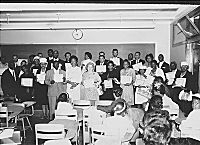| Entries |
| C |
|
Chicago Area Project
|

|
CAP sponsored community organizing committees composed of residents of high-delinquency neighborhoods. Shaw worked as much as possible through existing institutions, such as the Catholic church in the predominantly Polish neighborhood of Russell Square.
CAP's initial programs took three main forms. First, it organized recreation; the Russell Square Community Committee (RSCC), for example, sponsored a boys' club and athletic leagues. Second, it sought to improve neighborhood conditions; the RSCC cleaned up local parks and established a summer camp operated by community residents. Third, it intervened directly with delinquents; workers provided informal guidance (“curbstone counseling”) to youth gang members. Street workers also mediated with police and school officials when neighborhood youths were arrested or experienced difficulty in school. In addition, they supervised convicted offenders from the neighborhood when they were placed on parole.
CAP grew from 3 community committees in the 1930s to as many as 80 in the late 1960s. In many neighborhoods, the European ethnic groups whom CAP originally served were succeeded by Hispanics and African Americans. CAP has nonetheless remained an influential mechanism for community organizing.
The Encyclopedia of Chicago © 2004 The Newberry Library. All Rights Reserved. Portions are copyrighted by other institutions and individuals. Additional information on copyright and permissions.